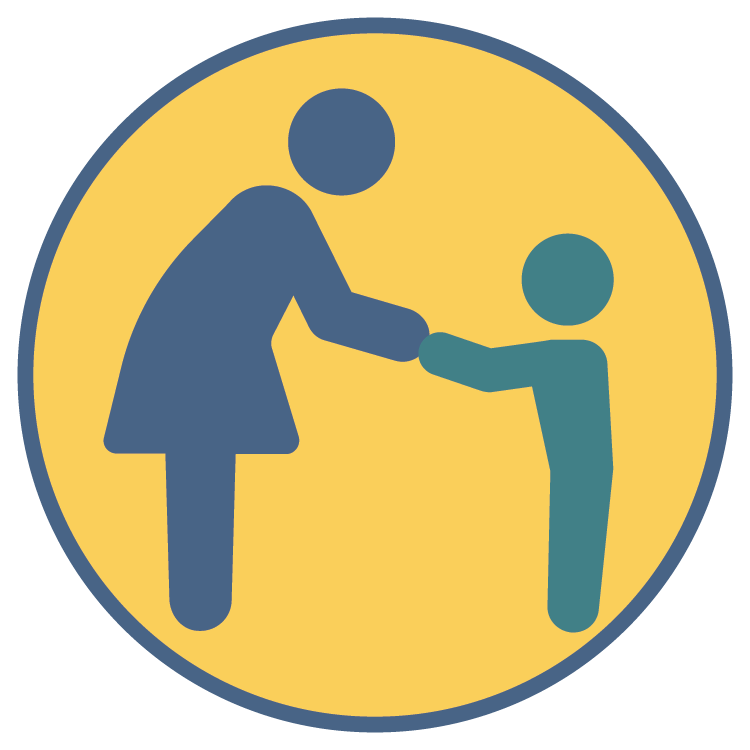Lesson 2 - Emerging Communication
In this lesson, you’ll learn about children who are communicating at an emerging level. We will cover strategies to support their communication development and ways to expand communication through conversation. You’ll also meet a number of children who are emerging communicators, see the different ways they communicate, and learn how their educators and families are supporting their communication development.
For more information, visit the National Center on Deafblindness at nationaldb.org.

Learning Objectives
Lesson 2 has three learning objectives. After completing the lesson, participants should be able to
- Describe the many ways emerging communicators who are deafblind communicate
- Identify strategies that support the development of a child’s emerging communication
- Explain how to engage in conversations with a child who is an emerging communicator to help expand their communication skills
Part 1 - What is Emerging Communication?
Topics Covered
- Examples of children who are emerging communicators
- The variety of types of emerging communication
- The importance of responding to a child’s communication
Activities
Instructors: The following activities can be adapted for a variety of purposes. For example, have participants turn in written or posted responses, or use the topics and questions as discussion starters. Some can be used for group activities.
Option 1
As you’ve learned in this part of the lesson, children who are emerging communicators communicate in a wide variety of ways. Watch this video and then describe how the child is communicating. What do you think he is trying to communicate?
Option 2
Explain why a child who is deafblind needs engaged communication partners who can recognize and affirm their communication.
Part 2 - Supporting Emerging Communicators
Topics Covered
- Slowing down and being present
- The importance of positioning
- Close observation
- Affirming communication
- Joint attention
- Hand-under-hand interactions
Activities
Instructors: The following activities can be adapted for a variety of purposes. For example, have participants turn in written or posted responses, or use the topics and questions as discussion starters. Some can be used for group activities.
Option 1
This two-minute video shows an early intervention consultant working with a child who is deafblind and at an emerging level of communication. As she interacts with the child, she explains what she’s doing to the child’s special education teacher. Watch the video closely, several times if you need to. Based on what you learned in this part of the lesson, describe the strategies the EI consultant is using. How do you think her use of these strategies benefits the child?
Option 2
You’ve learned in this section about the importance of using the hand-under-hand technique with a child who is deafblind. How does this technique impact a child’s communication and connections with others? In your response, include a discussion of what can happen if someone uses the opposite— hand-over-hand—when interacting with a child who is deafblind.
Part 3 - Expanding Communication Through Conversation
Topics Covered
- Conversations with and without language
- Reciprocal interactions, including imitation and turn-taking
- What to do if a child is not interacting with you
- Using shaping to encourage communication and concept development
- Communication using a head tracking device
Activities
Instructors: The following activities can be adapted for a variety of purposes. For example, have participants turn in written or posted responses, or use the topics and questions as discussion starters. Some can be used for group activities.
Option 1
You’ve learned in this section how imitation and turn-taking can be excellent ways to engage in conversations, support communication development, and build trusting relationships with a child who is deafblind and an emerging communicator. Describe an activity where you could use these strategies to connect and have fun with a child.
Option 2
Suppose you are trying to interact and communicate with a child who is an emerging communicator. You’ve used all of the strategies and techniques covered in this lesson, but nothing seems to be working. Describe two or three things you might do to find out whether the child is truly understanding what you are communicating.
Option 3
Imagine you overhear two educators talking about a child who is deafblind and does not communicate in conventional ways. One says that she’s frustrated because the child doesn’t seem to communicate. What might you say to these educators about how children who are deafblind communicate?
Quiz
Instructors are welcome to use this quiz as-is or adapt it to meet their needs. It can be used to test participants’ knowledge following completion of the module or for pre- and post-test evaluation. To obtain answers to the quiz, instructors should contact support@nationaldb.org.
Additional Resources
Supporting Communication Development: NCDB Practice Guide
Essential components of instructional practices commonly used to help children who are deafblind development communication
Everyone Has a Voice (Exceptional Parent Magazine)
A mother of a son who is deafblind shares his journey of communication
NCDB Info Topic: Emerging (Presymbolic) Communication
Factsheets and other resources on presymbolic communication in children who are deafblind
Building Communication Through Conversation
Ways to have conversations (e.g., turn-taking between a child and a communication partner) that do not require language
Hand-Under-Hand Technique: NCDB Practice Guide
A list of the skills a teacher or other adult working with a child or youth who is deafblind would display if implementing hand-under-hand strategies
